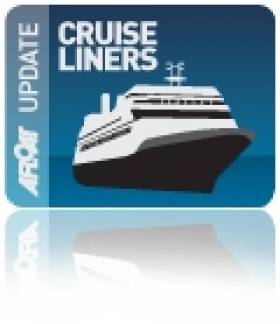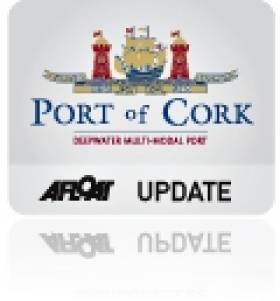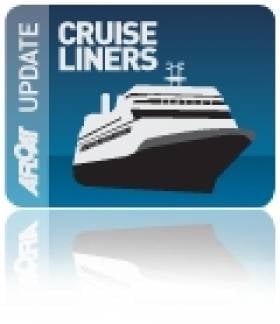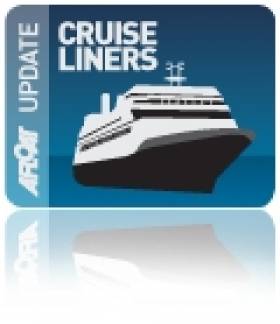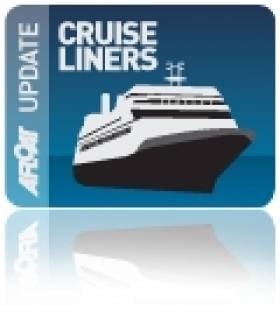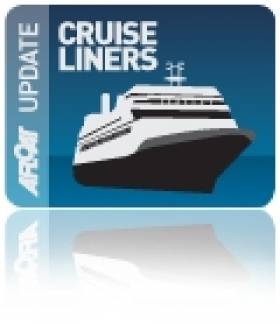Displaying items by tag: Cruiseliners
Ports & Shipping Review: EU Ports Conference, Irish Cargoship Strikes Rock, Cruise Sector, Lifeline for WWI Warship, Lightship Scrapped and more…
#PORTS & SHIPPING REVIEW - Over the last fortnight Jehan Ashmore has reported from the shipping scene, where the European Commission hosted a major ports conference on the EU policy framework for ports.
Irish Ferries won 'Best Ferry Operator' in an award held in Birmingham, which was presented by Group Leisure, a leading British travel trade publication.
A brand new Irish flagged cargoship, Huelin Dispatch (2012/2,545grt) struck a rock while on its maiden voyage from Southampton to the Channel Islands. No crew were injured and the vessel was re-floated and then proceeded to dry-dock in Falmouth.
Large cruiseship operators could be a source of funding for the proposed redevelopment of Galway Port, a Joint Oireachtas Committee on Transport and Communications has been told.
Next year cruise passengers will be able for the first time to travel directly from Ireland to Norway on a major cruiseship from Cobh operated by Royal Caribbean International.
The 98 year-old HMS Caroline, berthed in Belfast, is to be given a lifeline, after the Stormont Assembly is to allocate £100,000 for restoration work on the famous World War I warship.
An industrial dispute over crew salaries and conditions at Brittany Ferries which ran for ten days ended earlier this week and where sailings on the Cork-Roscoff route returned to service yesterday.
The former headquarters of the Commissioners for Irish Lights in Dublin 2 is for sale at €2.85 million on the instructions of Nama, which is 89% drop on the €26 m paid for the block in 2006 by Pembroke Partnership.
A report by the MCIB was published into the grounding of Arklow Raider (2007/2,999grt) at the mouth of the River Boyne in 2010, nobody was injured and no pollution occurred.
One of the last surviving Irish lightships, ALF Skua which was automated in the early 1980's, finally ended her days as work on scrapping took place on the banks of the River Avoca in Arklow.
Today marks the final day of the Open House Dublin weekend, which was organised is to make architecture more accessible to the public and free of charge. Among the events today are guided tours (first come, first served basis) of the current headquarters of the Commissioners of Irish Lights and the National Maritime Museum of Ireland also located in Dun Laoghaire. For details visit www.openhousedublin.com
Small Is Beautiful As Cruiseship Tours South-West Region
#COASTAL CRUISING – The world's smallest 5-star luxury cruiseship, Hebridean Princess (1964/2,112grt) is nearing the end of a 7-night 'South from Cork' fly-cruise, visiting locations only along the south-west coastline, writes Jehan Ashmore.
Accommodating just 50 guests in opulent surroundings styled as a 'country house party atmosphere', Hebridean Princess is a far cry from her previous career as a humble ferry serving in the Scottish western isles.
On her Irish cruise, she has called so far to Schull, Bantry, Glengariff, Castletownbere, Slea Head near Dingle and Kinsale.
What makes this cruise itinerary unusual is that the area covered is confined to a region. Normally other operators visiting Ireland, asides those just calling to one or two city ports, would visit ports stretching along the western seaboard. Also different is that this fly-cruise departs and returns from the same Irish port.
The final night of the cruise will be spent on board the vessel tonight, with the ship moored at North Custom House Quay, beside the Port of Cork Company building in the heart of the city docklands.
Prices for the cruise operated by Hebridean Island Cruises started from £3,400 per person which includes two gala dinners and return scheduled flights from selected UK airports to Cork.
Hebridean Princess will remain in Cork until tomorrow when she begins a 9-nights 'Gaelic Explorer' cruise with calls to Kinsale, Dublin, Isle of Man and Northern Ireland before returning to home waters in Scotland.
Baltic Sea Newcomer to Visit Dublin Port
#CRUISE LINERS - Finnish operated Kristina Katarina is to make her inaugural 'Irish' call this Thursday when she and two other cruiseships are scheduled to arrive in Dublin Port, writes Jehan Ashmore.
As previously reported on Afloat.ie, the newcomer is run by Kristina Cruises based in Kotka which lies some 50kms from the border with the Russian Federation. In 2010 the former Russian ship was brought to replace the ageing twin funnelled Kristina Regina.
The change of vessel was due to new safety regulations which forced the veteran vessel to withdraw from service with the replacement vessel built in 1982 at the New Szczecin Shipyard. The name of the Polish port city may sound familiar as the city is yet again the presenting sponsor of the prestigious Tall Ship Race Festival due to visit the capital in over a fortnight's time.
Kristina Katarina has a passenger certificate for around 400-passengers and she underwent renovations for her new owners. This saw changes to cabin accommodation where categories begin with the smallest inside cabins of 9m² to high standard ocean view cabins occupying 30m². In total she has a total of 193 cabins and 380 lower beds.
During the renovation new saunas were installed on deck 8 and on the pool deck there are three pools to cater for all the age-profiles of passengers.
After her Irish call she is to visit the Isles of Scilly and then to Brest, marking the end of a cruise. From the Breton port with its naval base, a new cruise embarks with passengers on a week long fly-cruise starting from Helsinki. The itinerary includes calls in Portugal, Gibraltar and Spain, where in Malaga the cruise terminates and a return flight to the Finnish capital.
Port of Cork Awarded 'Large Company of the Year'
#PORT OF CORK – The Cork Business Association recently awarded the Cork of Port Company as the 'Large Company of the Year for the 2nd Quarter 2012'.
The port is home to Irelands only dedicated cruise berth in Cobh, which during this year's season will see a total of 60 cruiseships visiting the harbour between April and November. In that timeframe more than 100,000 passengers and crew are to call to the region. According to Failte Ireland, the average spend per in-transit passenger approximately €73 per day which brings positive impacts for business in Cork.
Commenting on the award Brendan Keating CEO of the port said "We as a port are delighted to be receiving this award today from Cork Business Association. 2012 is proving to be another busy year for the cruise business in Cork, with 60 liners calling, of which three are operating part turnaround calls and ten liners are maiden visits to the port. We are continuing to work to grow our business and we have ambitious plans to increase to 80 cruise calls a season over the next five years".
He continued "While the port puts in a huge effort to bring the liners to Cork the business would not work without the relationship and continued joint efforts of the tour operators, ship-agents, bus companies, Irish Rail and local tourism groups".
Keating also emphasised the importance of the regions tourist attractions on offer, which helped to make the cruise business what it is today.
As of this week Afloat.ie adds that Hebridean Island Cruises 50 passenger Hebridean Princess is scheduled to call to Cobh overnight on Wednesday. At the start of next weekend sees Silverseas Cruises 296 passenger Silver Cloud call on Friday. Two days later the giant 3,592 passenger capacity Caribbean Princess is also to make an apperance berthing alongide the town's deepwater quay. For a list of cruise caller click HERE.
Cruiseship Calls with Suites by Ralph Lauren
#DESIGNER CRUISE SHIP – The cruiseship Marina (2011/65,999grt) which was only launched into service last year is on a port of call to Dublin today, having departed on a cruise from Dover, writes Jehan Ashmore.
Marina berthed alongside Ocean Pier this morning and the 1,250 passenger (double occupancy) vessel was built by Fincantieri Sestri Ponente in Italy for Oceania Cruises. The compnay also operate a sistership Riviera which was completed this year.
The 15-decked Marina which has 11 decks assigned for guests and served by a crew of 800. The guest to crew staff ratio is being 1.57 to 1. Oceania Cruises claim that the pair of mid-sized newbuilds are the most beautiful, elegant and sophisticated ships to debut in the past 50 years.
Designer features include the Lalique Grand Staircase and owner's suites furnished under the Ralph Lauren Home name, which showcase high quality standards in residential design and furnishings. Of the many facilities The Bon Appétit Culinary Center, is unique as it is the only hands-on cooking school at sea. There is also an artists-in-residence to teach fine arts in the Artists Loft.
To gain a greater insight to what's on board take a virtual tour of the vessel which has the following principle dimensions; length: 785 feet, beam: 106 feet and she draws on a maximum draught of 24 feet.
As is the norm the nationality of the staff hotel crew are international while the officers are European. She is registered in the Pacific island nation of the Marshall Islands.
#PORTS & SHIPPING REVIEW: Over the last fortnight Jehan Ashmore reported the shipping scene which saw President Higgins officially reopen the National Maritime Museum of Ireland in Dun Laoghaire.
The President was again on duty on the far side of Dublin Bay the next day to welcome the London Olympics 2012 Torch Relay on its first visit to the state in Howth Harbour, where the headquarters of the Olympic Council of Ireland are based.
The mid-west port of Galway was where the small German cruiseship Bremen made a port of call while at anchorage in Galway Bay.
Returning to the east coast in Dun Laoghaire Harbour, where the Water Wag's the oldest one design racing class in the world celebrate their 125 anniversary regatta week which culminates today.
Outside the harbour in Dublin Bay, the sight of a rig re-appearing was not for oil but for further preliminary work as part of the €220m Dublin Bay Project, where a new sewage pipeline outfall is to be built from Ringsend.
On the other side of the Irish Sea, the cruiseship Ocean Countess departed Liverpool City Cruise Terminal bound for Cobh. Her departure coincided on the 30th anniversary of the end of the Falklands Conflict, where in 1982, the cruiseship was used as a troopship to assist logistical operations after the 10-week long war ceased in June of that year.
Double Role Recalled as Cruiseship Sails South
#CRUISELINERS – Cruise & Maritime Voyages Ocean Countess (17,593 tonnes) departed Liverpool's City Cruise Terminal this evening bound for Cobh, though thirty years ago she sailed considerably further south and for completely different reasons, writes Jehan Ashmore.
The 800 passenger capacity was built in 1976 for Cunard Line as their Cunard Countess which undertook an unusual charter less than a decade later. For six months she was used as a troopship by the British Government's Ministry of Defence after the conclusion of the Falklands War in 1982.
The vessel's deployment was to support troop movements between Ascension Island and Port Stanley whilst the islands airfield at Port Stanley was being reinstated.
She sailed 8,000 miles to the South Atlantic islands, where families and friends of British personnel lost in the conflict were also carried on one round voyage. This was to enable commemorations to take place at sea and ashore. Today marks the end of the war, where further commemorations were held on the islands and in the UK.
Call Opens Galway Harbour Cruiseship Season
#CRUISE LINERS – Galway Harbour Company welcomed the first cruise caller this year with the Silver Explorer an expedition cruiseship with a capacity for over 130 guests, writes Jehan Ashmore.
The 6,072 tonnes vessel is on a cruise from Bordeaux and her most recent ports of call have been to Glengariff and Waterford. This evening the ship heads for Killybegs where passengers will visit the north-west.
For the rest of the season Galway port is scheduled for eight more cruise calls. Two cruise calls are scheduled in mid-August while the Silver Explorer is to make a return visit later that month. She is no stranger to Irish waters having served as the former Prince Albert II.
Olympic Bound Cruiseship On Overnight Dublin Call
#OLYMPIC CRUISESHIP – A cruiseship which is to be used as accommodation ship for key workers during the London Olympic Games is currently on a UK mini-cruise including today's overnight call to Dublin Port, writes Jehan Ashmore.
The cruiseship Braemar (1993/24,344grt) has been chartered by the organisers of the global sporting event for over a month. Around 900 personnel are to use the 195 metre-long vessel as their 'floating' accommodation during the games which is run by the London Olympics and Paralympic Games (LOCOG). Most of the workers will be involved in transportation duties for competitors and officials from 12 July – 15 August.
The vessel is to berth in East London Dock (Albert Dock or King George V) which is close to the ExCel Centre, the exhibition venue which has hosted London Boat Show's over the years, will be used for a number of Olympic events. In addition the location is close to the main transport hub for the Olympic workers and is also nearby to London City Airport.
As a consequence of the cruiseship's 34-day long charter, three cruises have been cancelled by the vessels owner Fred Olsen Cruise Lines.
Guests who were originally booked on the affected cruises on board the Braemar have been offered alternative itineraries. In addition the company provided a goodwill gesture to acknowledge the inconvenience while those passengers who choose not to take up this offer have been given a full refund.
Last month the same owners organised a special Titanic Memorial Cruise which called to Cobh, having completed a mini-cruise to Belfast to mark the historical centenary of the liner's construction at Harland & Wolff Shipyard.
#FORMER IRISH PRESIDENT ON CRUISE – Former President of Ireland, Mary Robinson was a guest speaker on board the National Geographic Explorer during the first leg of a 14-day 'Exploring the British Isles and Irish Isles' cruise which departed the UK last week, writes Jehan Ashmore.
The theme of the lecture was about the perspective and context of 'modern' Ireland which formed part of the 'Global Perspective Programme' organised by the cruise operator Lindblad Expeditions.
Robinson who was also a former UN High Commissioner for Human Rights was also a guest speaker on the same vessel a year ago, where she shared her insights on what was then the recent historic visit of Queen Elizabeth II to Ireland.
The 148 passenger cruiseship is today on the start of an itinerary of the western Scottish Isles, having passed yesterday evening the 2,000-foot Slieve League, the highest sea-cliffs in Europe. The 6,471 tonnes vessel departed Killybegs from where her guests travelled to Glencolumbkille.
In addition she had anchored earlier in the morning between Inishmurray Island and Grange, Co. Sligo. The 228-acre island which has a 6th century monastery was inhabited until abandoned in 1948.
Since the cruise began in Portsmouth the vessel has called to several locations and the Irish west coast to the Skelligs, Dingle Peninsula, Kilronan on Inishmore of the Aran Islands and Cliffs of Moher.
It is to such destinations that are typically visited by Lindblad Expeditions in partnership with the National Geographic Society (NGS) which produces the renowned monthly magazine. At isolated and more inaccessible destinations passengers make shore excursions using Zodiac tenders.
In addition to hosting forums such as the Global Perspective Programme, the strategic alliance with NGS enables renowned experts from the society scientists, naturalists and photographers to accompany guests on visits to field sites that include those committed in sustainable geo-tourism.
National Geographic Explorer was built as Midnatsol in 1982 for Hurtigruten of the Norwegian Coastal Voyages. She is ice-strengthened and is the largest of the Lindblad fleet.
Several years ago the interiors were completely gutted-out in a Spanish dry-dock, resulting in an essentially different ship for her new role with many high-tech features and equipment incorporated. The most impressive being a remotely operated vehicle, or ROV, which can dive 1,000 feet below the ice.



























